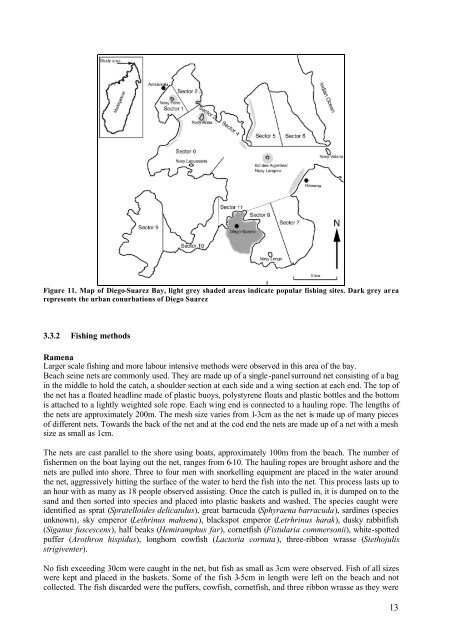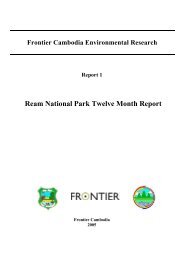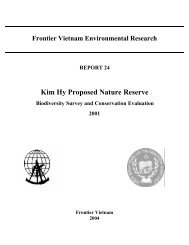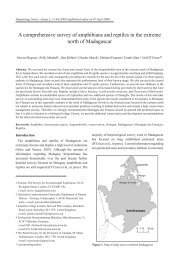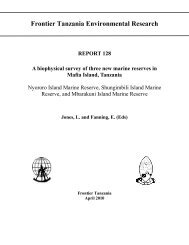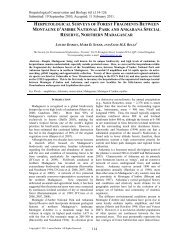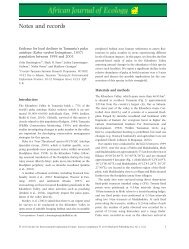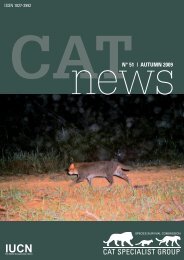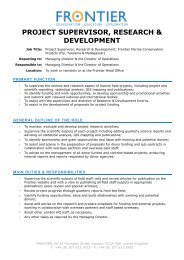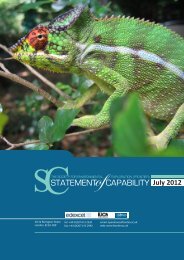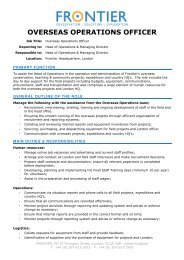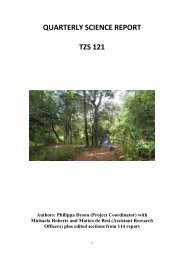An assessment of local fisheries in Diego-Suarez Bay, Madagascar
An assessment of local fisheries in Diego-Suarez Bay, Madagascar
An assessment of local fisheries in Diego-Suarez Bay, Madagascar
Create successful ePaper yourself
Turn your PDF publications into a flip-book with our unique Google optimized e-Paper software.
Figure 11. Map <strong>of</strong> <strong>Diego</strong>-<strong>Suarez</strong> <strong>Bay</strong>, light grey shaded areas <strong>in</strong>dicate popular fish<strong>in</strong>g sites. Dark grey area<br />
represents the urban conurbations <strong>of</strong> <strong>Diego</strong> <strong>Suarez</strong><br />
3.3.2 Fish<strong>in</strong>g methods<br />
Ramena<br />
Larger scale fish<strong>in</strong>g and more labour <strong>in</strong>tensive methods were observed <strong>in</strong> this area <strong>of</strong> the bay.<br />
Beach se<strong>in</strong>e nets are commonly used. They are made up <strong>of</strong> a s<strong>in</strong>gle-panel surround net consist<strong>in</strong>g <strong>of</strong> a bag<br />
<strong>in</strong> the middle to hold the catch, a shoulder section at each side and a w<strong>in</strong>g section at each end. The top <strong>of</strong><br />
the net has a floated headl<strong>in</strong>e made <strong>of</strong> plastic buoys, polystyrene floats and plastic bottles and the bottom<br />
is attached to a lightly weighted sole rope. Each w<strong>in</strong>g end is connected to a haul<strong>in</strong>g rope. The lengths <strong>of</strong><br />
the nets are approximately 200m. The mesh size varies from 1-3cm as the net is made up <strong>of</strong> many pieces<br />
<strong>of</strong> different nets. Towards the back <strong>of</strong> the net and at the cod end the nets are made up <strong>of</strong> a net with a mesh<br />
size as small as 1cm.<br />
The nets are cast parallel to the shore us<strong>in</strong>g boats, approximately 100m from the beach. The number <strong>of</strong><br />
fishermen on the boat lay<strong>in</strong>g out the net, ranges from 6-10. The haul<strong>in</strong>g ropes are brought ashore and the<br />
nets are pulled <strong>in</strong>to shore. Three to four men with snorkell<strong>in</strong>g equipment are placed <strong>in</strong> the water around<br />
the net, aggressively hitt<strong>in</strong>g the surface <strong>of</strong> the water to herd the fish <strong>in</strong>to the net. This process lasts up to<br />
an hour with as many as 18 people observed assist<strong>in</strong>g. Once the catch is pulled <strong>in</strong>, it is dumped on to the<br />
sand and then sorted <strong>in</strong>to species and placed <strong>in</strong>to plastic baskets and washed. The species caught were<br />
identified as sprat (Spratelloides delicatulus), great barracuda (Sphyraena barracuda), sard<strong>in</strong>es (species<br />
unknown), sky emperor (Lethr<strong>in</strong>us mahsena), blackspot emperor (Letrhr<strong>in</strong>us harak), dusky rabbitfish<br />
(Siganus fuscescens), half beaks (Hemiramphus far), cornetfish (Fistularia commersonii), white-spotted<br />
puffer (Arothron hispidus), longhorn cowfish (Lactoria cornuta ), three-ribbon wrasse (Stethojulis<br />
strigiventer).<br />
No fish exceed<strong>in</strong>g 30cm were caught <strong>in</strong> the net, but fish as small as 3cm were observed. Fish <strong>of</strong> all sizes<br />
were kept and placed <strong>in</strong> the baskets. Some <strong>of</strong> the fish 3-5cm <strong>in</strong> length were left on the beach and not<br />
collected. The fish discarded were the puffers, cowfish, cornetfish, and three ribbon wrasse as they were<br />
13


